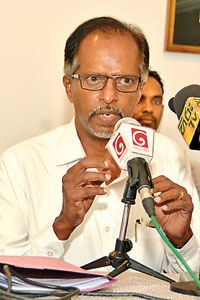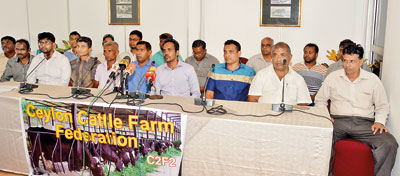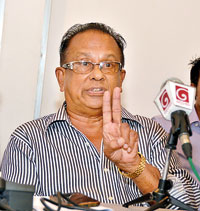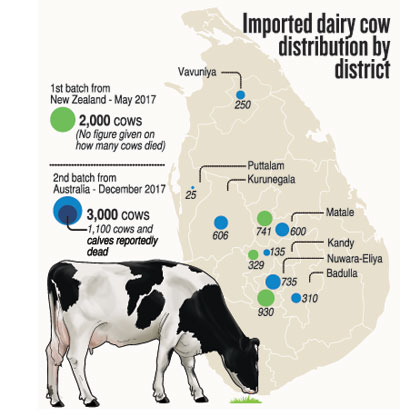News
Milky dream turns sour Farmers
Farmers who imported pregnant heifers through govt face huge debts; blame the authorities over broken promises; and allege corruption
By Kumudini Hettiarachchi and Ruqyyaha Deane
View(s):

- These cows don’t have a pedigree, claims Amal Suriyage
The project was the first step towards making Sri Lanka self-sufficient in fresh milk and reducing the dependence on powdered milk. Many were the traditional dairy farmers and also entrepreneurs who were lured by full-page advertisements with the slogan ‘High-yielding imported pregnant cows’ placed by the Rural Economy Ministry.
This was two years ago. Fast forward to 2019 and all those who invested huge amounts of money in this project have hit the depths of despair.
Many of them are drowning in debt, with some even mortgaging their personal assets and a few contemplating taking their own lives, while they have seen their cows die before their very eyes. Broken promises are what they face, they say, with even the price they were offered for the milk not materialising.
The dream of contributing to the dairy industry and the development of the country has evaporated, embroiling them in a living nightmare, many farmers lament, alleging serious lapses and corruption on the part of those involved in implementing the project.
Appeals and requests have not yielded any results, just adding to the ‘souring’ of the milky dream and they are vociferous, personally to the Sunday Times and at a media briefing held by the Ceylon Cattle Farmers’ Federation (C2F2) at the BMICH in Colombo on Thursday afternoon with the participation of around 25 farmers. (Please see box and map for project details)

- Amal Suriyage
Soon after the media briefing, around 4.30 p.m., the farmers handed over a thick file with all the documentation to the Presidential Commission of Inquiry to Investigate Corruption and Fraud Allegedly Committed in State Institutions, at the BMICH, said farmer Amal Suriyage of the Lammermoor Estate in the Nuwara Eliya district who had bought 200 cows, of whom 55 are now dead.
Mr. Suriyage alleged that 15 of the 21 clauses in the contract between Wellard Rural Exports Pty Ltd. Australia and the Economic Development Ministry of Sri Lanka had not been fulfilled, but declined to provide a copy of the contract on the grounds that he was planning to go to court. He also alleged that some of the essential information with regard to the cows, such as quarantine procedures carried out in Australia before the cows were shipped and in Sri Lanka after they arrived here, which was their right to know had to be obtained through numerous applications under the Right To Information (RTI) Act.
The issues highlighted by
the farmers include:
- Of the 67 farmers who bought the dairy cows under Phase I and II, 5% have closed down their farms — but this will increase to 20-25% soon.
- Of the 3,000 cows bought by them under Phase II, 19% have died.
- The farmers and the government paid a very high price for the cows which were unhealthy and not of an expected standard, whereas such cows are being sold cheaper on the internet.
- The quarantine procedures have not been transparent.
- Although, the promise was that the cows would be pregnant having been artificially inseminated before importation, some of them were not, while others had aborted during the long shipment time and also while being transported tightly-packed in small lorries once they landed in Trincomalee.
- The cows are afflicted with deadly diseases such as Bovine Viral Diarrhoea (BVD), Mycoplasma, Salmonella Dublin and Heifer Mastitis.
- The technical support required by the farmers when constructing the cow-sheds and during calving was not given.
- The yield of milk promised did not pan out, neither did the milk price promised – 12% of the cows do not give milk.
- The selected cows did not suit the climatic conditions of Sri Lanka.
- The cost of feed was becoming a killer, with no proper income from milk production.
A traditional dairy farmer who had been having a successful business before he welcomed 16 rata saththu into the fold, Saman Kumara from Kuliyapitiya in the Kurunegala district, laments with emotion that the imported cows have destroyed his livelihood.
“Of the 16 imported cows, four are dead and one is sick. Saththu kora gagaha thama genawe. (The animals were limping when brought.) They have also not given the promised milk yield,” says Mr. Kumara, pointing out that he has spent a lot of money on medicines. “Api asarana wela inne, ape pavula vinasha vela.” (We have hit rock-bottom and our family has been destroyed.)

- A cow suffering from Mycoplasma on Amal Suriyage’s farm
Another traditional dairy farmer, Angappan Angamuttu from the Rothers A Farm in the Nuwara Eliya district who got 150 imported cows, having sold off his own local cows, was adamant that even though he bought the imports for Rs. 200,000 each, now he cannot even sell one for Rs. 35,000. They are not worth 5 cents.
If the cows lactated properly then there would not be any problems and the project would have been a success, he says, explaining that the cows have a lot of health problems.
Earlier, woman farmer, Mahesha Wijesooriya of the Nikakotuwa Farms in the Matale district who got 50 cows (eight have died so far) who was the first to bring the grievances of the farmers to the Sunday Times said the authorities and companies involved in the project were very helpful and understanding at the beginning because the project was new, but now even to get a little thing done they will say we have to pay beforehand.
“We continued for about four months initially, but it went downhill from there. At no point did we get a profit or break-even,” she said.

- The farmers at the media briefing on Thursday. Pic by M.D. Nissanka
For Eranga Nihan of Agasas Holdings from the Kandy district who purchased 40 animals, his business has collapsed and he has been forced to sell off all of them.
Why didn’t the government import cows from a country such as India, but opt for Australia and New Zealand, the climate of which does not suit Sri Lanka, he queried. “The government didn’t force the cattle on the farmers, we took them willingly, trusting the government not to ruin our livelihoods.”
Mr. Suriyage, meanwhile, added that even though the contract clearly mentioned that if a cow is not up to standard, it would be replaced within 90 days, most farmers were not aware of this crucial point, as the authorities had failed to tell them so.
He strongly rejected counter allegations by both the ministry and Wellard that the farmers were not feeding and maintaining the animals, stressing that even if the family starved they fed the cows.
Pointing out that poster-eating road cows would have been better than the cows the government has imported, Mr. Suriyage alleged at the media briefing that there was corruption.
“We want to expose the culprits, we are the victims,” he added.
| Solutions from a farmer
Describing the project as “an utter failure”, farmer Pani Wanigasekera of the Heladiva Plantations in the Kurunegala district who purchased 30 cows, said in despair that many are the meetings they have had with officials and politicians to no avail. He says that at such meetings “minutes are taken but hours are lost”, while pointing out that as soon as the cows were unloaded on his farm he questioned the Wellard personnel as to whether they were from Australia or Ethiopia. Here are the solutions, Mr. Wanigasekera suggests to pull the farmers out of this terrible mess they are in:
Mr. Wanigasekera alleges that even though the Rural Economy Ministry’s Project Director, Dr. Sagarika Sumanasekara assured that they had sent a Cabinet paper for approval in which the grace period for the interest is to be extended as well as the capital payment from 5 years to 10 years, nothing has happened yet. | |
|
Stage I is implemented as two phases — in May, under Phase I, the first batch of 2,000 ‘pregnant dairy heifers’ arrives from New Zealand, is unloaded at the Trincomalee harbour and distributed to 21 farmers. In December, under Phase II, the second batch of 3,000 ‘pregnant dairy heifers arrives, is unloaded at the Trincomalee harbour and distributed to 47 farmers. The agent and transporter of the cows is Wellard Rural Exports (described on their website as the leading supplier of quality meat and livestock worldwide) and their local agent is Foresight Engineering Pvt. Ltd. (a solutions provider in development, technical, cutting-edge technology) and part of the Access Group of Companies. Farmers’ management issues are the problem – Project Director ‘Main findings were farm management issues, delay in milk payments by collectors, issue of loan re-payment and cost of feeding’ The problems on the farms are due to management issues by the individual farmers, stressed the Rural Economy Ministry’s Project Director, Dr. Sagarika Sumanasekara, when contacted by the Sunday Times. The expected outcome is there on farms which are being managed well, she said. Here are the detailed questions of the Sunday Times and the Project Director’s answers. The Sunday Times is awaiting more answers to several follow-up questions, which have been promised this week. Which ministry in Sri Lanka imported the cows? Was the Department of Animal Production and Health involved in all stages of this project? The Ministry of Rural Economy was the importer and the Department of Animal Production and Health provided related technical support including the post-import quarantine process, animal selection in New Zealand and Australia and supervision and continuous treatments through the provincial Departments of Animal Production and Health. How was Wellard Rural Exports chosen to be the supplier of the cows under this project? Were tenders called from similar companies and the required process followed when selecting Wellard? What was the role of Wellard after the cows arrived in Sri Lanka? It has been selected by the former Ministry of Livestock and Rural Community Development following tender procedures. Further Cabinet approval has been taken by the Ministry of Economic Development to use the same company for the new project, too. The role of Wellard after the cows arrived in Sri Lanka is to transport the animals to selected farms, provide technical guidance and advice for a successful farm operation, conduct training programmes, continuous monitoring of farms and assist in management problems. Close monitoring provided for six months. As this is a live operation, the success of the farm depends on the farm management including proper feeding, health and environment management. What was the fee charged by Wellard? How was that fee paid? Who paid the fee? Wellard charged USD 17.6Mn for the first phase to import 5,000 animals. Wellard was paid through the EFFIC/Foreign Bank by the ERD (External Resources Dept. of the Ministry of Finance) with the recommendation of the ministry. How much did the cows cost? How much did the Sri Lankan farmers pay and how much did the Sri Lankan government pay for each cow? The cost of a cow is USD 3,032. The farmer paid a subsidized rate of Rs. 200,000/- per cow and the government bore the balance sum of Rs. 267,000/- (according to the currency rate at the time of arrival). There are allegations that on the internet similar type of cows are being sold at a lesser amount, at almost half. Is this true? From whom did the SL Government buy the cows? SL bought the animals from Wellard through their supplier farms according to the requirements and health protocol provided by Sri Lanka. Who selected the cows before importation to Sri Lanka? Did a team from Sri Lanka go there? If so, how long did they stay there? What did the team checkout in the cows? Were medical certificates on the cows obtained? A team of five technical experts from Sri Lanka selected the animals and they spent 8 days to select the animals in Victoria, Australia. (The answer to a follow-up question by the Sunday Times how each member of the technical team would have selected 75 cows per day, is being awaited.) Was a quarantine process followed there and in Sri Lanka when the cows arrived here? A. Yes. The pre-export quarantine process was done in an Australian quarantine farm and the post-export quarantine done in Sri Lanka by the quarantine unit of the Dept. of Animal Production and Health. Were all the cows healthy and pregnant when they arrived on the private farms in Sri Lanka? Yes. The animals require a certain period to adapt to the new environment after three weeks’ shipping. A few animals had aborted and those farmers were paid Rs. 50,000/- and they were impregnated after a certain period. Further, some animals were replaced due to certain defects caused during the quarantine period. These were not in the agreement, but it was done for the sake of farmers Has there been an audit on this phase of the project? If so, what are the findings? Main finding was the farm management issues, delay in milk payments by collectors, issue of loan re-payment and cost of feeding. Many of the farmers are complaining of unhealthy animals being given to them and also that no technical support was forthcoming. They allege that they have incurred huge debts but the project has not yielded the expected outcomes. Please comment on these allegations. Farmers were supplied healthy animals but due to management issues some animals were diseased. These are common diseases like mastitis purely caused due to bad environment management, tick fever etc. These are diseases in Sri Lanka. BVD virus was not present in any adult animals. There is a risk of having less than 2% in calves born, but that cannot be tested before birth so that can be tested after birth and if present these animals removed. The BVD antibody has been identified in Sri Lanka before these animals were imported. The expected outcome is there in the farms which are managed well. To get the good profit from a dairy farm it will take more than three years. Initially (with capital expenditure) expenditure is higher than the income. But later on this will give a good profit with increasing milk yield by lactation, new born calves, sale of cow dung and other extra activities. Will the next phase of the project be continued? Not yet confirmed. A comprehensive interview with the Technical Dairy Advisor & International Project Manager, Johann Wasserman of Wellard Rural Exports Pty Ltd., which was readily given to the Sunday Times when asked, will be published shortly. However, numerous attempts by the Sunday Times to get information from Foresight’s Project Engineer, P. Kumarage failed.
|



 The project at a glance
The project at a glance